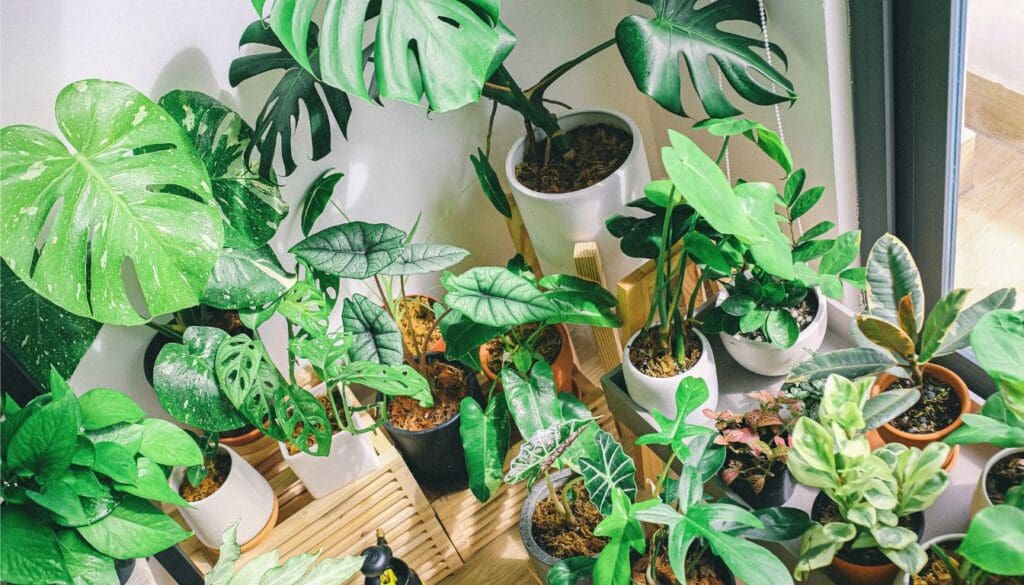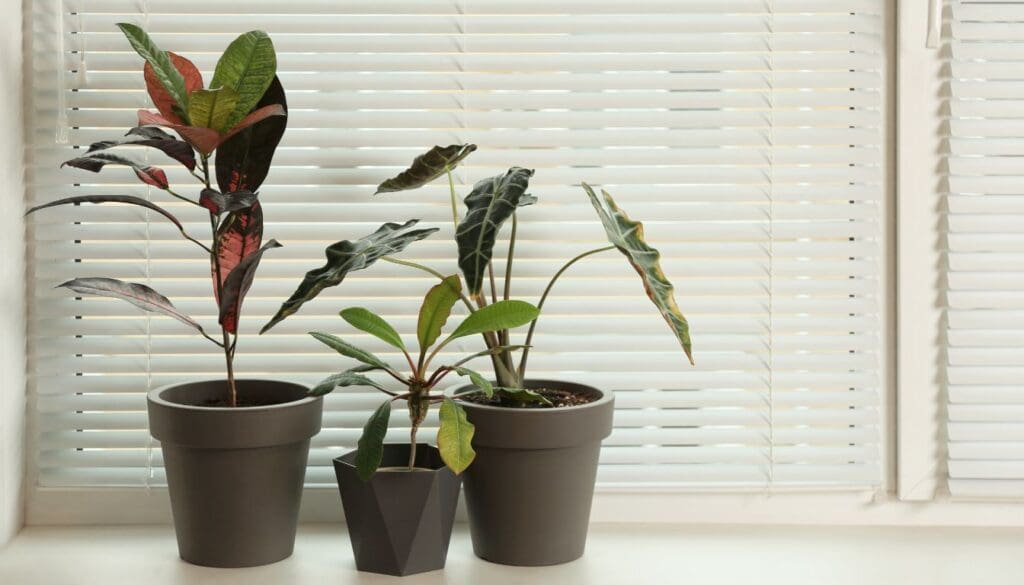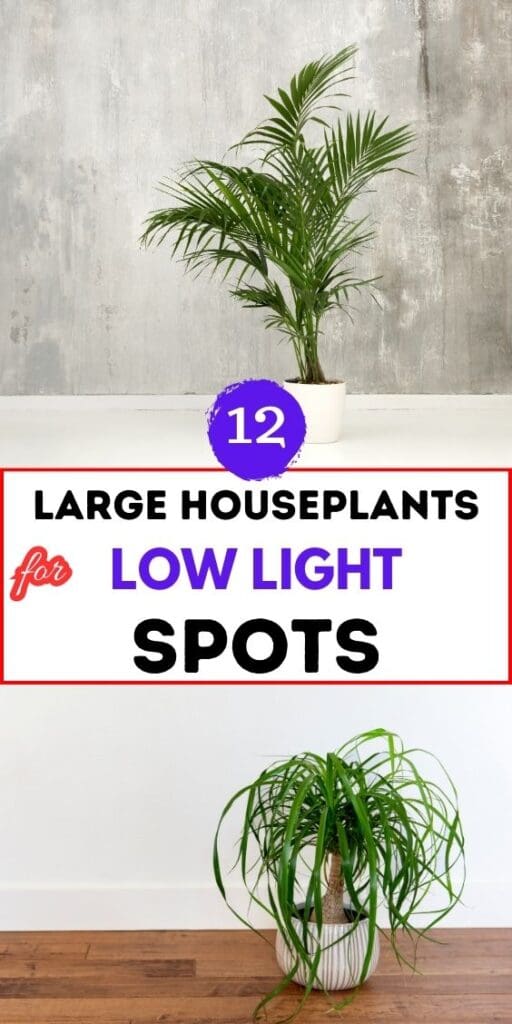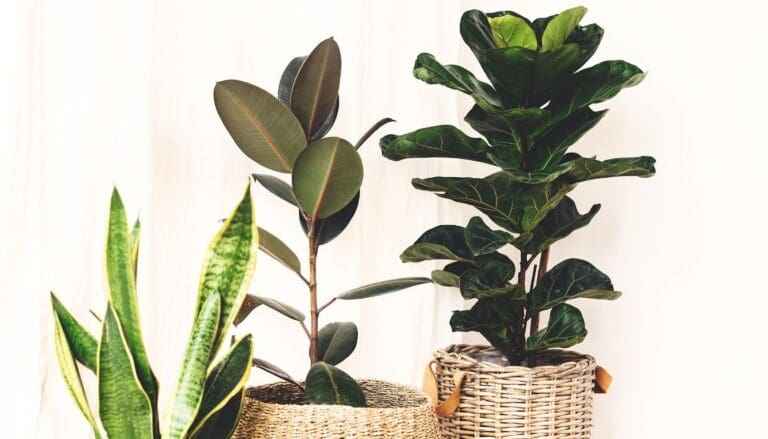12 Large Houseplants For Low Light Spots
Nowadays, most plant lovers are restricted to compact apartments with very little or no open space or sufficient sunlight, but that should not be a barrier to growing plants in your house.
Generally, ample sunlight is required for plants to thrive, but many plants can grow in lower light conditions. Large plants like Swiss cheese, Dragon trees, Rubber plants, and Snake plants can grow in low light, though their best growth comes in bright light.
This article will discuss the care requirements of growing large plants in low-light homes and some of the ideal tall plants for these areas.

Please note: Simplify Plants is reader-supported. Some links in the post are affiliate links and I get a commission from purchases made through links in the post.
What is a low light condition for plants?
The amount of sunlight is always more outdoors than indoors.
Even the shady spot in your garden has more light than the bright window inside your home.
The term “bright light” refers to indoor spots that receive unobstructed sun, and there is no barrier blocking the sunlight from reaching the plant.
“Medium” sunlight refers to spots with barriers like a sheer curtain between the light source and the plant.
“Low light” is where direct sunlight does not reach and is several feet away from the window.
When we describe a plant as a low-light plant, we must understand that it can tolerate low-light conditions.
It is important to remember here that plants may grow in low light, but they might not thrive the way they do in bright sunlight.
You can keep these plants a few feet away from the window or keep them at spots under shades.
How do plants survive low light?

Light tolerance is a complex process that needs to be understood closely.
Plants adapt to the light conditions they grow in their native habitat.
Plants like ferns, alocasia, etc., grow in forests under the canopy of bigger trees.
Thus, they do not get direct sunlight but only receive dappled and indirect sunlight.
So these plants are well suited in low light areas because they are naturally adjusted to tolerate low light.
In many cases, plants’ physical characteristics also make them tolerate low lights.
Plants with wide leaves covering a large surface can absorb more light, even in low-light areas.
For example, plants like Monstera Deliciosa or Swiss cheese have big leaves with slits, which help them absorb the maximum light from the environment.
That’s how they can grow in low-light forests, floors, and homes.
Low-light plants are also called shade-tolerant plants sometimes.
Some of these plants do not like being exposed to direct sunlight, which burns their delicate leaves quickly, and some of them, though enjoying bright light, can also adapt to lower sunlight levels.
Can we grow plants in windowless rooms?
The good news is for those who want to grow plants in offices, chambers, or rooms without windows.
Yes, you can grow low-light plants in windowless rooms, but there must be some artificial light source.
Plants cannot live without light, but that light can be either sunlight or artificial light.
Though plants growing in natural light tend to grow faster and healthier than those grown under artificial lights, the latter can compensate for natural sunlight if your indoor space does not have any.
You can choose from the different artificial grow lights available in the market, like incandescent, fluorescent, LED, etc.
Low light plants
A tall indoor plant towering over furniture and décor pieces is the ultimate statement piece accentuating any house.
So now let us talk about the popular plants you can grow in your low-light houses.
1. Snake plant

The snake plant, also known as the mother-in-law’s tongue, is one of the perfect low-light plants you can put almost anywhere in your home.
The plants come in various shapes and sizes, like the dwarf and compact ones that grow like a rosette or tall and narrow ones.
NASA also recommends these plants for their excellent air-purifying qualities
Snake plants are very easy, one of the easiest plants to maintain indoors.
They are very hardy and drought resistant and can survive neglect.
Snake plants are succulents, and coming from dessert areas, the leaves are equipped to store water in them, so they require very less watering as they are prone to overwatering.
2. Swiss cheese plant

The huge leaved beauty is one breathtakingly gorgeous plant that elevates indoor spaces.
These plants can grow up to a tall height and have big leaves with holes or cuts on them that give them the name Swiss cheese.
The large slits in them protect them from heavy downpours or strong hurricanes, which otherwise might have damaged their big leaves.
In nature, they grow over 20 feet tall; however, indoors, they can reach a height of 6-8 ft. if given the correct conditions to grow.
These plants are native to tropical rainforests, growing under shades of bigger trees.
Hence they cannot tolerate direct sunlight falling on them.
They enjoy indirect light indoors and require humidity to thrive.
Misting benefits them, and you can use humidifiers to maintain humidity around them.
Fertilize them in the rowing season with all-purpose liquid fertilizer or compost.
3. Dragon tree

Dragon trees are famous and one of the popular varieties of large indoor plants that are hardy and suit busy plant lovers.
Though they flourish best in bright light, in lower lights, they survive though the growth is much slower.
Indoors they can reach up to 6ft in height and will need repotting every 2-3 years.
The narrow-bladed leaves in multiple colors like purple, red, or burgundy add a texture to your dull corners.
Dragon trees do not need a lot of maintenance, and they are happy with soil that is well-draining and breathable and dries out in between watering.
These plants are sensitive to cold drafts and fluctuations in temperature, so keep them away from air conditioners or windy spots.
4. Corn plant

Belonging to the dracaena family, the corn plants, or Dracaena Fragrans, have leaves resembling corn stalks on the top of thick woody stems.
They look unique and dramatic as the plants fill empty corners with their tall, slender body.
They are also known as mass cane because of their tall cane-like trunk.
They are very well suited in low-light homes, do not like direct sunlight, and get burned quickly.
They can grow over 6ft tall indoors and are thus quite ideal for filling up our homes.
Ensure that the soil has excellent drainage but can also retain moisture.
They enjoy humidity as well and are toxic to pets if ingested.
5. Ponytail Palm

Ponytail palms are almost indestructible and are a great addition to low-light homes.
They are easy to grow and do not require much attention.
They have an unusual and fascinating body with long strappy leaves sprouting from a thick trunk that stores water in them, thus needing very less watering, making them prone to overwatering.
These plants are very slow growers but can reach 6 feet indoors in low lights situations and grow much taller, up to 15-20 feet tall in more light conditions.
6. Dieffenbachia

Dieffenbachia or dumb canes are popular indoor plants that create dramatic statements as houseplants.
They have large variegated leaves with speckled and splotched marks and do not like direct sunlight, which scorches them easily.
These plants can reach height of5 feet in low light, with large leaves up to 12 inches wide.
They grow best in dappled sunlight or low light during summers and spring when the sunlight is strong.
They do not like fluctuations in temperature or cold drafts.
The sap of this plant is toxic and can be poisonous if consumed, so keep them away from the reach of children or pets.
7. Yucca cane

While choosing tall indoor plants that survive low lights, yucca cane has to be mentioned.
They are happy in low-light corners with their leathery green foliage.
They grow slower in low light, but they will be fine if you refrain from overwatering them.
Indoors they can grow to 8 feet tall and enjoys soil that is slightly on the drier side.
8. Weeping fig

Weeping figs belong to the Ficus family of plants and are commonly seen gracing hallways in all offices.
They look more like large trees than smaller houseplants.
The plant’s stems are woody, and the leaves are shaped like narrow arrows.
9. African mask

African mask, also known as alocasia, is a unique-looking houseplant belonging to tropical regions.
They have unique dark green leaves shaped like arrows or large shields with protruding veins in contrasting colors.
Depending on the variants of the plants, they are 2ft to 5ft in height and 2ft-5ft in width.
They are well suited in low-light areas and instantly add a lot of volume to homes with their stunning foliage.
These plants want a lot of humidity and enjoy standing in moist soil.
10. Rubber plant

A favorite among indoor plant growers, rubber plant or focus elastic is a plant you must choose if you want to add an elegant indoor plant to your collection.
They can reach an astounding height of 6ft to 10ft indoors.
And outdoors, they grow into full-fledged large trees.
Rubber plants are also native to the tropical rainforests of Asia and are loved for their large waxy leaves that come in different colors per their variants that stand as a distinctive feature.
Some variants of the plant have dark green leaves, some have burgundy and some variants also have almost black leaves.
There are also the variegated versions of the plant, which require more light to maintain their variegation.
However, buying more mature and established plants for low light conditions is recommended rather than the young ones, which would grow very slowly in low light.
Once the plant has reached maturity, you can place them in low-light spots, and it will survive without much problem.
11. Lady’s palm

They are slow-growing plants that grow into perfect indoor trees that add a lot of volume to empty spaces.
Lady palms or Rhapis Excelsa grow up like small trees with a cluster of fan-like fronds.
They add striking elements to corners with their busy green fronds.
Feed them actively in the warmer months and water them when the topsoil dries off.
They are somewhat drought resistant, so only water them occasionally and trim them in the growing season to maintain the desired shape.
12. Parlor palm

Parlor palm is one of the most enigmatic tall indoor plants native to Mexico that does well in low light.
They have been quite popular since the Victorian era and are thus quite a stunning decorative piece.
The tropical fronds of this plant add a lot of summery breathable touch to low-light homes.
They can grow uptp4-5 feet indoors and add a striking statement appeal indoors.
They adapt themselves easily to lower light conditions and can tolerate neglect too.
They are drought tolerant and do not like standing in wet soil as they are prone to root rot.
They enjoy warm, humid conditions and keep them away from cold, dry air.
They respond well to humidifiers to maintain humidity levels.
Care tips for low-light houseplants
Here are some care tips for growing plants in low light:
1. Do not overwater plants growing in low-light areas.
The more sunlight a plant gets, the more water it requires because evaporation rates are higher with sunlight.
So, as the water absorbs quickly, the plant gets thirstier frequently.
The plant’s growth increases with more light, resulting in higher photosynthesis and transpiration.
This is why plants grow faster in summer and spring than in winter.
In low light, the water evaporation levels are low, so the soil stays wet for longer.
If unsure when to water, dip your finger in the soil or use a moisture meter to check the moisture content.
Remember to empty the cache or trays underneath the pots to empty them.
If you overwater your plants, it may lead to root rot, fungus and pest growth, mushy stems and leaves, blackened leaves, and wilting.
2. Light exposure
Remember, your plants can tolerate low light, but it still needs light.
They can tolerate low light, but their best growth always occurs in brighter areas.
The growth rate can be lower in low-light areas than the growth in more light.
Insufficient light can lead to problems like legginess, feeble stems, more space between the leaves, wilting, etc.
Thus you must ensure that even if your plants can grow in low lights, they must get sufficient light.
If you see any low-light-related problems in your plants, you must move them to a more sunlit area.
Installing artificial grow lights, especially in winter, is a great way to boost the light needs of the plants.
This is because, in winter, the intensity of natural light reduces, so artificial light can help to compensate for the lack of sunlight.
But in summer, when the light intensity is more, most low-light plants do fine without artificial light.
3. Reduce fertilizing
Since most plants grow slower in low-light areas, they do not need much fertilizer except during the growing season.
Over-fertilizing can burn them and damage the roots and lead to salt accumulations.

Sources: University of Minnesota, David H. Trinklein, Horticulture State Specialist, The University of Georgia, The Royal Horticultural Society.
Recommended Garden Supplies
| Product Image | Our Recommended Gardening Supplies | Check Offers! |
|---|---|---|
Top Top
Top
Top
Top
Top
Top
Top
Top | rePotme Houseplant and Tropical Classic Potting Soil Mix | Check Offer On Amazon |
 Top
Top
Top
Top
Top
Top
Top
Top | Espoma Organic Indoor Plant Food | Check Offer On Amazon |
 Top
Top
Top
Top
Top
Top
Top
Top | GooingTop LED Grow Light 6000K Full Spectrum Clip Plant Growing Lamp | Check Offer On Amazon |
 Top
Top
Top
Top
Top
Top
Top
Top | Soil Moisture Meter | Check Offer On Amazon |
 Top
Top
Top
Top
Top
Top
Top
Top | Govee Hygrometer Thermometer, Bluetooth Enabled! | Check Offer On Amazon |
 Top
Top | LEVOIT Humidifiers for Large Room(Best For Plants) | Check Offer On Amazon |
 Top
Top
Top
Top
Top
Top
Top
Top | Upgraded DIY Automatic Drip Irrigation Kit, 15 Potted Houseplants Support | Check Offer On Amazon |
 Top
Top
Top
Top
Top
Top
Top
Top | Stainless Steel Heavy Duty Gardening Tool Set | Check Offer On Amazon |
 Top
Top
Top
Top
Top
Top
Top
Top | Bonide Insecticidal Soap | Check Offer On Amazon |
 Top
Top
Top
Top
Top
Top
Top
Top | Bonide 32 oz Spray Neem Oil for Organic Gardening | Check Offer On Amazon |
 Top
Top
Top
Top
Top
Top
Top
Top | Garden Safe Fungicide | Check Offer On Amazon |





